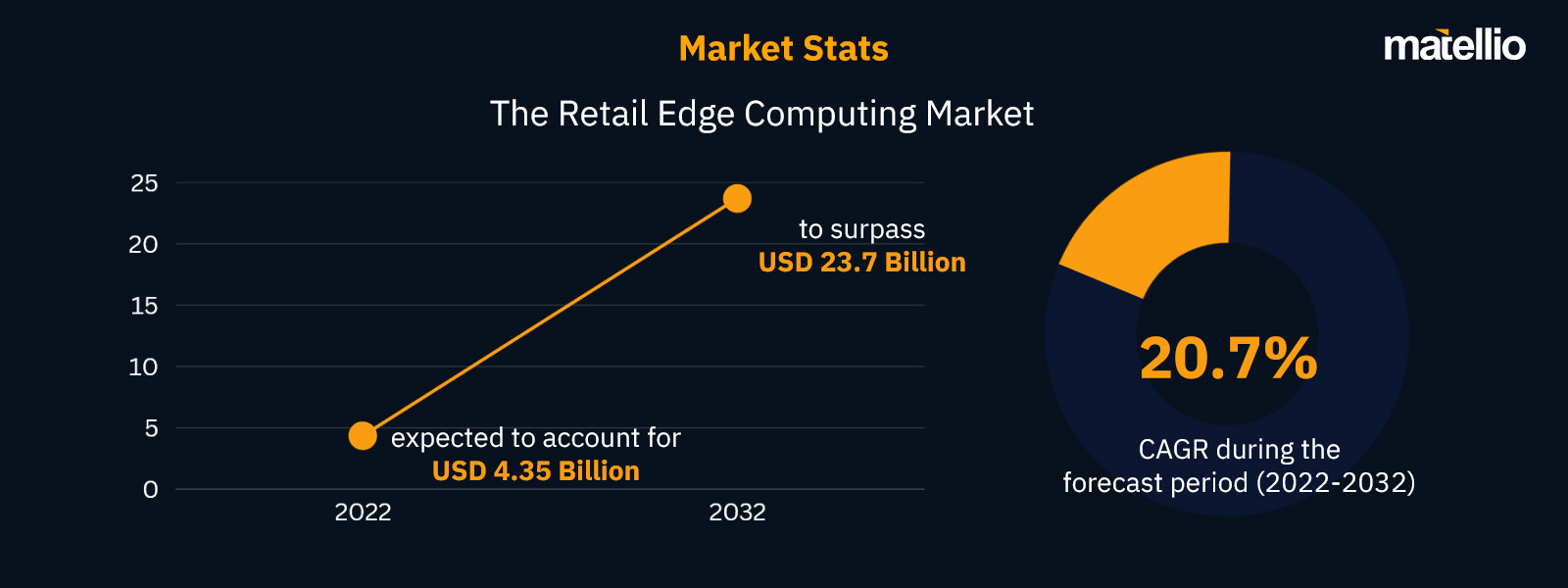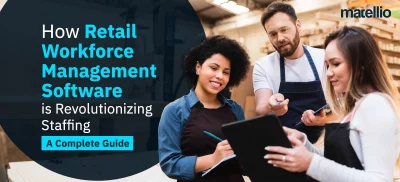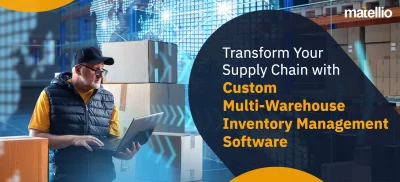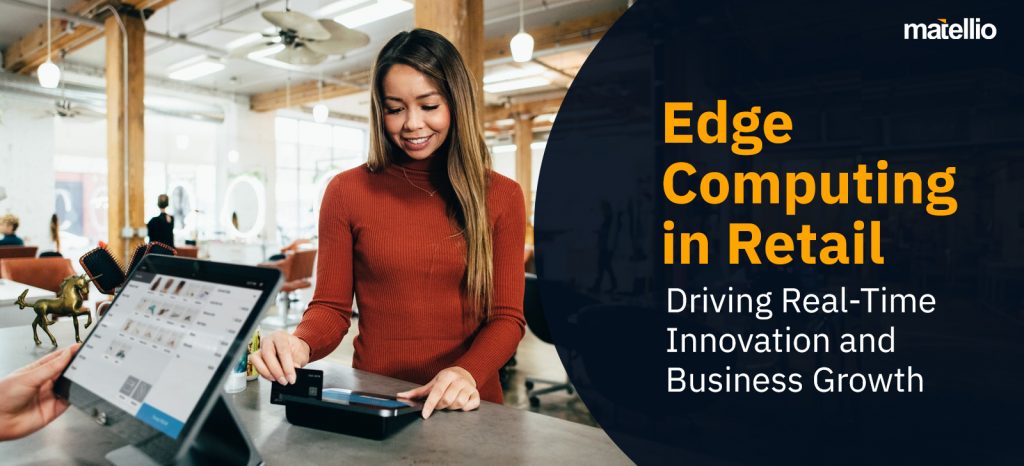
Retail is evolving rapidly, with businesses demanding faster, smarter, and more responsive technology solutions. Edge computing in retail is emerging as a game-changer, enabling retailers to enhance customer experiences, optimize store operations, and make real-time decisions.
Unlike traditional cloud computing, where data is transmitted to a centralized server for processing, edge computing processes information closer to the source—whether at the store, checkout or within smart devices. This shift reduces latency, strengthens security, and provides real-time insights, helping retailers stay competitive in an increasingly dynamic market.
For retailers looking to deliver seamless customer experiences, reduce operational inefficiencies, and unlock new revenue opportunities, edge computing is not just an option—it’s a necessity.
What is Edge Computing in Retail?
Edge computing is a distributed IT architecture that processes data closer to where it is generated, reducing the need to send large volumes of information to be centralized cloud servers. This is particularly crucial for retail businesses where speed, accuracy, and security play a significant role in daily operations.
Source – Market Research Future
How Does Edge Computing Differ from Traditional Cloud Computing?
Traditional cloud computing depends on remote servers to process and analyze data, often causing delays and increasing network load. In contrast, edge computing in retail enables data processing at the store or device level, ensuring instant responses for critical retail functions such as sales transactions, inventory management, and customer interactions. By minimizing reliance on external data centres, edge computing significantly reduces bandwidth usage, lowering operational costs while enhancing overall system efficiency.
Another key advantage is enhanced security and compliance. Since sensitive customer data is processed locally within controlled retail networks, the risk of cyber threats and data breaches is drastically reduced. This ensures that businesses maintain strict security protocols while adhering to regulatory compliance. Additionally, retailers can operate efficiently even in network-restricted environments, ensuring uninterrupted service and a seamless customer experience.
The Role of Edge Computing in Retail
The adoption of edge computing is revolutionizing in-store operations by enabling real-time decision-making across various retail processes. Retailers can instantly process sales transactions, manage inventory updates, and adjust pricing dynamically based on real-time consumer demand and market trends. This level of operational agility enhances customer experience, reduces wait times, and ensures better stock management.
Beyond transactional benefits, edge computing use cases in retail extend to optimizing store layouts, staff scheduling, and product placements. With real-time data at their fingertips, retailers can adjust displays, ensure adequate staffing during peak hours, and arrange high-demand products in optimal store locations. The ability to analyze in-store customer movement patterns also allows businesses to refine marketing strategies, personalize customer engagement, and ultimately drive higher revenue.
Retailers looking to integrate advanced, real-time computing solutions into their business operations can benefit from Digital Transformation Services, which help streamline deployment and maximize the potential of edge-powered retail innovation. This transformation ensures that businesses remain agile, data-driven, and competitive in an evolving marketplace.
Key Benefits of Edge Computing in Retail
Retailers adopting edge computing in retail industry gain a significant competitive advantage by making faster, data-driven decisions, reducing costs, and enhancing customer interactions. By processing data closer to the source, retailers can create smarter, more responsive store environments that optimize efficiency and customer satisfaction. Here’s how edge computing in retail is transforming the industry.
Faster Checkout & Reduced Wait Times
- One of the biggest pain points in retail is long checkout queues, leading to cart abandonment and customer dissatisfaction. Edge computing in retail solves this issue by enabling instant transaction processing at the checkout counter, rather than relying on remote servers for data verification.
- By reducing network latency, transactions are completed in real time, ensuring that payment verification and automated POS systems work seamlessly.
- Retailers can also integrate smart self-checkout kiosks and mobile payment solutions powered by edge computing, further eliminating delays and enhancing the overall shopping experience.
Optimized Inventory & Supply Chain Management
- Retailers need to ensure that high-demand products are always available while avoiding overstocking. Cloud computing in retail traditionally manages inventory by storing vast amounts of data on remote servers, but edge computing use cases in retail now allow businesses to track stock levels in real time.
- By using smart shelves and automated inventory tracking systems, retailers can detect low stock levels instantly and trigger restocking before products run out. This reduces manual errors, prevents stock shortages, and ensures that customers find what they need when they need it.
- Additionally, automated reordering systems powered by edge computing can optimize supply chain logistics, ensuring smooth operations across multiple store locations.
Personalized Customer Engagement
- Modern consumers expect tailored shopping experiences, and retailers that fail to meet these expectations risk losing customers.
- Edge computing in retail industry allows businesses to analyze real-time customer behavior and provide personalized recommendations, promotions, and discounts while customers are still in the store.
- For example, smart digital signage and interactive kiosks can display customized product suggestions based on previous purchases or in-store browsing patterns.
- Additionally, retailers can use location-based services to send personalized push notifications with special discounts when customers are near relevant product sections. This level of engagement enhances customer satisfaction, builds brand loyalty, and drives higher sales.
Improved Loss Prevention & Security
- Retailers lose billions of dollars annually due to theft and fraud. Traditional security systems often rely on cloud-based surveillance, but edge computing use cases in retail have revolutionized loss prevention by processing security footage in real time.
- AI-powered video surveillance systems running on edge devices can detect suspicious activity instantly, triggering alerts for security personnel before a theft occurs.
- Additionally, edge-powered fraud detection can identify unusual purchase patterns, helping businesses mitigate financial losses from fraudulent transactions.
- By reducing the need to send massive amounts of data to external servers, retailers can process security insights faster, prevent losses more effectively, and enhance in-store safety.
Read More: Stay ahead of theft and fraud with cutting-edge Retail Loss Prevention Software Development for smarter retail security.
Reduced Cloud Dependency & Lower Costs
- Retailers traditionally depend on cloud computing in retail for storing and processing vast amounts of customer and operational data. However, this reliance comes with high bandwidth consumption and storage costs.
- Edge computing in retail reduces this dependency by processing critical data locally, minimizing bandwidth usage and cloud storage expenses.
- Instead of continuously transmitting large data volumes to the cloud, edge computing filters, processes, and analyzes information at the source, only sending essential data to the cloud for long-term storage. This results in significant cost savings while ensuring real-time operations remain uninterrupted.
Greater Reliability & Uptime
- Retailers cannot afford downtime, as network failures can bring business operations to a standstill. Edge computing in retail industry ensures that stores continue functioning even during network outages, unlike traditional cloud computing, which requires a stable internet connection for data processing.
- By processing transactions, inventory updates, and security data locally, retailers can maintain business continuity and serve customers without disruption.
- Whether it’s an internet failure or cloud service downtime, edge computing keeps store operations running smoothly, safeguarding revenue and ensuring an optimal shopping experience.
Smarter Store Operations & Automation
- Efficiency is the backbone of successful retail operations, and edge computing in retail powers smart store automation, reducing operational inefficiencies and cutting unnecessary costs.
- For example, AI Solutions Retail enables smart lighting and energy management systems to use edge computing to adjust lighting and temperature automatically based on store occupancy, reducing energy consumption and lowering electricity costs.
- Similarly, automated staff scheduling ensures that employees are assigned based on real-time customer traffic, ensuring optimal workforce utilization during peak hours while cutting excess labor costs.
- Retailers can also use edge-driven systems to analyze real-time shopping behaviors and optimize product placements, ensuring best-selling items are positioned for maximum visibility and sales.
Boost Retail Performance by Reducing Latency, Enhance Security, And Optimize Processes! Retailers across industries are leveraging edge computing in retail to enhance efficiency, customer engagement, and operational success. By processing data closer to the source, edge computing ensures faster responses, smarter automation, and improved decision-making, enabling businesses to stay competitive in an evolving market. Below are some of the most impactful edge computing use cases in retail and how they are reshaping operations. One of the biggest challenges in retail is long checkout lines, leading to customer frustration and abandoned purchases. Edge computing in retail industry provides smart checkout solutions and self-service kiosks that process transactions instantly, reducing wait times and enhancing customer convenience. By locally processing payment verifications and item scans, edge-powered checkout systems reduce reliance on external cloud servers, minimizing latency and ensuring seamless transactions. These systems also enable self-service kiosks with AI-driven assistance, helping customers navigate purchases, loyalty programs, and payment processing effortlessly. By integrating real-time transaction processing, retailers increase efficiency, reduce staff dependency, and improve customer satisfaction while optimizing store operations. Efficient inventory management is critical for retail success. Cloud computing in retail traditionally handles large volumes of inventory data in centralized data centers but delays in processing can result in stock shortages or overstocking. With edge computing use cases in retail, businesses can track inventory at the shelf level in real-time. Smart shelves, RFID tags, and IoT-enabled tracking devices automatically update stock levels and alert store managers to low inventory, misplaced items, or potential theft. This technology ensures that products are always available to customers, reducing lost sales while helping retailers minimize waste, control storage costs, and improve overall supply chain efficiency. Retailers must anticipate demand fluctuations to optimize stock levels and maximize profitability. Traditional forecasting relies on historical sales data, often leading to inaccurate predictions. With edge computing use cases, retailers can analyze real-time purchasing patterns to enhance forecasting accuracy. By processing live sales data, businesses can dynamically adjust pricing, promotions, and stock allocation based on customer demand. This approach prevents inventory imbalances, reduces markdown losses, and ensures that high-demand products remain available. This level of intelligence enables retailers to respond proactively to market trends, improve profitability, and create a more data-driven retail strategy. Retail is a highly dynamic industry where pricing strategies significantly impact consumer behavior. Traditional pricing models depend on periodic data updates, making it difficult to react quickly to market fluctuations or competitor strategies. By leveraging edge computing in retail, businesses can implement real-time dynamic pricing, adjusting prices instantly based on customer demand, competitor rates, and regional trends. Edge-powered systems can also personalize promotions, offering tailored discounts based on a shopper’s in-store behavior and past purchases. This ensures that retailers remain competitive, maximize revenue, and provide a more personalized shopping experience for customers. Retailers need to understand how customers move through their stores to optimize product placement, marketing strategies, and in-store layouts. Traditional analytics systems depend on cloud computing in retail, but processing delays limit the ability to make quick adjustments. With edge computing use cases in retail, smart cameras, sensors, and beacons provide real-time insights into customer movement, helping retailers: By leveraging instant customer insights, retailers can refine their merchandising strategy, increase sales, and improve overall store efficiency. Retail staffing costs are among the largest operational expenses, and inefficient scheduling can lead to poor customer service, labor shortages, or high staffing costs. Traditionally, workforce scheduling is based on historical patterns rather than real-time data, limiting adaptability. With edge computing use cases, retailers can analyze live store traffic data to optimize staff scheduling dynamically. By tracking peak foot traffic hours, businesses can adjust workforce allocation, accordingly, ensuring that employees are deployed efficiently. This approach prevents overstaffing during slow periods and understaffing during rush hours, leading to cost savings and a better in-store experience for customers. Retail shrinkage due to theft and fraud continues to be a major concern, costing businesses billions of dollars annually. Traditional security systems rely on cloud-based video analytics, which can result in delayed alerts and slow response times. With edge computing in retail industry, video surveillance and security monitoring are processed in real time, allowing retailers to: Since security data is processed locally at the edge, retailers can respond to threats immediately, minimize losses, and enhance overall store safety. Read More: For businesses seeking deeper insights, exploring retail business analytics can enhance store performance with actionable data on sales trends, customer preferences, and efficiency. While edge computing in retail offers transformative benefits, its implementation comes with several challenges that businesses must address. From high initial costs to regulatory compliance, overcoming these obstacles requires strategic planning and the right technology approach. Below are some of the key challenges in deploying edge computing use cases in retail and the solutions to ensure a smooth transition. The upfront costs associated with edge computing in retail industry can be a concern for many retailers. Setting up an edge infrastructure requires investment in hardware, software, and integration with existing systems. Many businesses hesitate due to the perceived complexity and financial burden of deploying edge computing solutions across multiple locations. Although the initial investment may seem high, the long-term benefits far outweigh the costs. By reducing operational inefficiencies and improving speed, edge computing in retail significantly lowers expenses over time. Businesses can start by implementing edge computing in high-impact areas, such as checkout systems or security monitoring, before scaling to other operations. With edge computing use cases in retail processing data locally rather than in centralized cloud environments, security and data privacy have become major concerns. Retailers must ensure that sensitive customer data, including payment information and personal details, is protected from cyber threats and breaches. Implementing on-device encryption ensures that customer data remains secure, even if an edge device is compromised. Real-time threat detection mechanisms can identify and prevent cyberattacks before they cause damage. Retailers should also enforce strict access controls to limit data exposure, ensuring that only authorized personnel can access critical information. Retailers often rely on legacy systems for point-of-sale, inventory management, and customer analytics. Integrating cloud computing in retail with these existing technologies can be complex, requiring changes in IT architecture and data workflows. A lack of compatibility with current software can slow down adoption and create inefficiencies. A phased implementation approach can help retailers integrate cloud computing without disrupting daily operations. Instead of overhauling the entire IT infrastructure at once, businesses should start with pilot projects in select locations or for specific retail operations. This allows for gradual scaling while identifying and addressing integration challenges early. Unlike centralized systems, edge computing use cases require managing multiple edge devices across different store locations. Keeping track of performance, updates, and maintenance across a large number of distributed devices can become a significant operational challenge. Retailers can use centralized device monitoring and management platforms to simplify the process of maintaining edge computing use cases. Automated update systems ensure that devices receive necessary software patches and security fixes without manual intervention. Predictive maintenance powered by artificial intelligence can also identify potential failures before they occur, reducing downtime and minimizing disruptions to business operations. Deploying and maintaining RPA for retail requires a specialized skill set that many retail businesses may not have in-house. Retailers must have access to experts who understand both IT infrastructure and retail-specific challenges to ensure a successful deployment. Partnering with technology providers and automation experts can bridge the skills gap and ensure smooth deployment. Managed service providers can help retailers with implementation, maintenance, and ongoing support, allowing internal teams to focus on core business functions. Additionally, investing in employee training programs enables existing IT staff to upskill and manage robotic process automation more effectively. Retailers depend on seamless connectivity to ensure real-time data processing and smooth operations. However, network disruptions, slow connections, and bandwidth limitations can impact the performance of edge computing in retail industry. If not properly addressed, connectivity issues can result in delays, data loss, or system downtime. Deploying a hybrid edge architecture ensures that retailers have a backup system in place when connectivity issues arise. A hybrid model allows businesses to process time-sensitive data locally while sending less critical information to cloud storage for long-term analysis. Edge caching and data compression techniques can also reduce bandwidth usage and improve network performance. Additionally, retailers should invest in redundant network infrastructure, such as multiple internet service providers (ISPs) or 5G-enabled connectivity, to prevent service disruptions. Retailers handle large volumes of customer data, making compliance with data protection laws essential. Regulations such as the General Data Protection Regulation (GDPR) in Europe and the California Consumer Privacy Act (CCPA) in the U.S. impose strict requirements on data collection, storage, and security. Non-compliance can result in hefty fines and damage to the brand reputation. Retailers must adopt an automated compliance monitoring system that continuously tracks regulatory changes and ensures that edge computing use cases in retail remain compliant. Data anonymization techniques can help protect customer privacy by removing personally identifiable information before processing. To ensure full compliance and security, retailers should submit RFP to connect with experienced legal and cybersecurity experts who can guide them in meeting industry-specific regulations while maintaining a secure edge computing environment. Also Read: Explore how Custom Retail Operations Software can streamline your business by unifying processes with AI-driven decision-making and advanced analytics for smarter operations and enhanced efficiency. Ready to Implement Edge Computing in Retail with Real-Time Automation? A structured approach is essential for retailers to successfully integrate edge computing in retail into their operations. By following a step-by-step plan, businesses can ensure seamless deployment, maximize efficiency, and drive measurable improvements across various aspects of retail management. Below are the key steps to implementing edge computing in retail and how expert guidance can enhance the process. The rapid advancement of technology is driving a major shift in retail, with edge computing in retail playing a critical role in optimizing operations, enhancing customer experiences, and streamlining business processes. As more retailers embrace edge-driven solutions, they unlock new opportunities for automation, real-time insights, and operational efficiency. Below are key trends shaping the future of edge computing in the retail sector. Retailers are leveraging automation to streamline in-store operations, reduce manual intervention, and improve efficiency. AI integration services are enhancing edge-driven automation, enabling self-checkout kiosks that eliminate wait times, AI-powered inventory management that detects low-stock levels, and smart pricing systems that adjust dynamically based on demand. By processing data closer to the source, these automated systems ensure faster responses and more efficient store operations. Personalization has become a key differentiator in modern retail, and edge computing use cases are making real-time customer insights more accessible than ever. By analyzing customer preferences, past purchases, and in-store behavior, retailers can instantly adjust product recommendations, targeted promotions, and personalized in-store experiences. Edge computing ensures that data processing happens instantly, allowing businesses to provide hyper-personalized interactions without latency or delays. Sustainability is a growing priority in retail, and cloud computing in retail is enabling smarter, more energy-efficient store environments. Intelligent lighting, automated HVAC systems, and AI-driven power optimization ensure that stores consume energy efficiently, adjusting consumption based on foot traffic, time of day, and weather conditions. By integrating real-time energy monitoring with cloud-based systems, retailers can significantly reduce costs while promoting eco-friendly operations. Retailers are increasingly turning to automation to improve logistics and last-mile delivery. Edge computing in retail industry is powering AI-driven delivery systems, enabling real-time route optimization, automated package sorting, and predictive demand forecasting. Edge-based tracking ensures accurate shipment monitoring, allowing retailers to deliver products faster while minimizing inefficiencies in warehouse management. With digital payments becoming the norm, retailers need highly secure and instant transaction processing. Edge computing use cases in retail improve payment verification by processing transactions locally, reducing the risk of cyber threats and speeding up checkout experiences. Advanced fraud detection systems powered by edge AI enhance security, ensuring that transactions remain safe while delivering a frictionless payment experience for customers. Retailers are focused on creating integrated shopping experiences that bridge the gap between online and offline channels. Retail Intelligence Software Development enables real-time synchronization of inventory, pricing, and customer data across all platforms. Whether customers browse online and buy in-store or engage with digital kiosks while shopping in person, edge-driven solutions ensure a smooth, consistent experience. This omnichannel approach enhances customer satisfaction and drives higher engagement. The rollout of 5G networks is set to further enhance edge computing in retail by enabling ultra-fast data processing and connectivity. With improved speed and reduced latency, retailers can implement advanced solutions such as AI-driven chatbots, smart digital signage, and real-time inventory tracking. The combination of 5G and edge computing will unlock new retail innovations, making stores more responsive, efficient, and connected. Willing to Future-Proof Your Retail Business with Edge-Driven Security Solutions? Edge computing is revolutionizing the retail industry by enabling faster decision-making, real-time data processing, and enhanced customer experiences. Implementing edge computing in retail allows businesses to optimize operations, improve security, and reduce latency in critical processes such as inventory management, checkout systems, and customer analytics. Our tailored edge computing solutions empower retailers with intelligent automation, seamless integration, and scalable infrastructure to stay ahead in a competitive market. Our team of experts specializes in developing edge-powered retail solutions that integrate with your existing systems and provide instant insights for better operational control. By leveraging technologies like AI, IoT, and real-time analytics, we help retailers enhance efficiency, boost sales, and improve customer engagement. If you’re ready to transform your retail operations with edge computing, fill out the form and connect with our team today. Let’s create a tailored solution that enhances efficiency, strengthens security, and elevates customer satisfaction! Edge computing enables real-time data processing at the store level, reducing latency, improving checkout speeds, and providing instant insights for inventory management and customer engagement. Yes, our solutions are designed to seamlessly integrate with existing POS, CRM, and supply chain management platforms, ensuring a smooth transition without disrupting operations. Timelines vary based on business requirements and complexity. After an initial consultation, we provided a detailed roadmap to ensure efficient deployment and minimal disruption. Absolutely. We provide continuous support, including system monitoring, performance optimization, security updates, and staff training to ensure long-term success. Costs depend on the scale of deployment, required features, and infrastructure needs. We offer transparent pricing models, ensuring cost-effective solutions that maximize ROI for your retail business.Use Cases of Edge Computing in Retail
 Smart Checkout & Self-Service Kiosks
Smart Checkout & Self-Service Kiosks  Real-Time Inventory Management
Real-Time Inventory Management  AI-Powered Demand Forecasting
AI-Powered Demand Forecasting  Intelligent Pricing & Promotions
Intelligent Pricing & Promotions  Store Traffic & Customer Behavior Analytics
Store Traffic & Customer Behavior Analytics
 Automated Staff Scheduling
Automated Staff Scheduling  Theft Prevention & Security Surveillance
Theft Prevention & Security Surveillance
Challenges of Implementing Edge Computing in Retail & Their Solutions
High Initial Investment
Solution
Security & Data Privacy Concerns
Solution
Integration with Existing IT Infrastructure
Solution
Managing Large-Scale Edge Devices
Solution
Need for Skilled IT & Retail Experts
Solution
Network & Connectivity Challenges
Solution
Compliance & Regulatory Hurdles
Solution
Steps for Implementing Edge Computing in Retail
Define Your Business Objectives
Choose the Right Edge Computing Infrastructure
Ensure Seamless Integration with Existing Systems
Prioritize Security & Compliance
Optimize & Scale Gradually
Leverage Retail Analysis Software for Performance Insights
Future-Proof with Retail Software Development
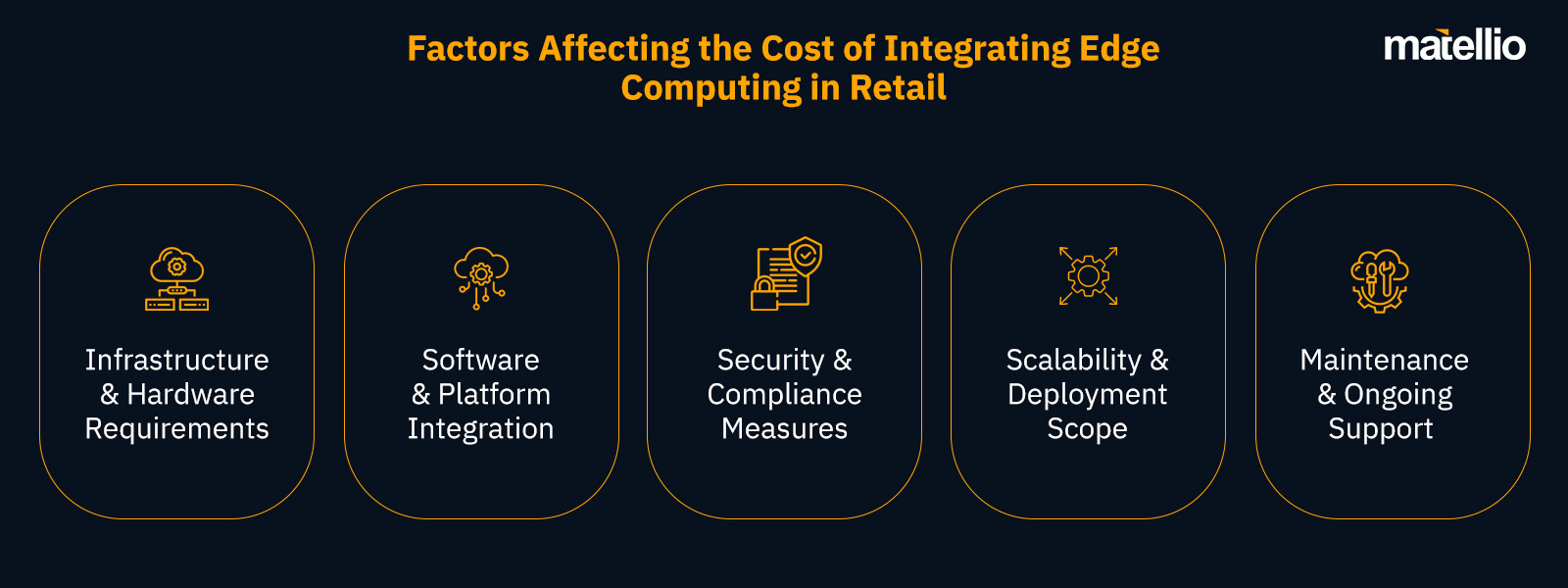
Future of Edge Computing in Retail
 AI-Powered Store Automation
AI-Powered Store Automation  Real-Time Customer Insights for Personalization
Real-Time Customer Insights for Personalization  Energy-Efficient Smart Stores
Energy-Efficient Smart Stores  Autonomous Delivery & Logistics
Autonomous Delivery & Logistics  Faster & More Secure Digital Payments
Faster & More Secure Digital Payments  Seamless Omnichannel Retail Experiences
Seamless Omnichannel Retail Experiences  5G-Driven Retail Innovation
5G-Driven Retail Innovation How Can We Help You with Edge Computing in Retail?
Here’s How We Can Help You:
Edge Computing in Retail – FAQ’s
Q1. How does edge computing improve retail operations?
Q2. Can edge computing integrate with our existing retail infrastructure?
Q3. What is the timeline for implementing edge computing in retail?
Q4. Do you offer post-implementation support?
Q5. What are the costs of implementing edge computing in retail?
